US Open, New York
August 26-September 8, 2002; 128 Draw (32 seeds); Surface – Hard
Pete Sampras hadn’t been able to win a tournament more than two years, but during the US Open 2002 he pieced everything together: his serve was lethal, other strokes worked well, and he won all the crucial points in the last five rounds of the tournament against players who could have theoretically beaten him – the last five encounters of his career too – because he didn’t play another professional match afterwards!
All scorelines
First round: Howard Fendrich
Little was ordinary about the start of the U.S. Open for third-seeded Tommy Haas, from being ordered to change out of a sleeveless shirt to three consecutive double faults in the fifth set. Haas and his foil, David Sanchez, produced enough theater for 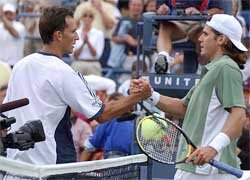 a round’s worth of matches. Haas pulled out a 7-6(1), 3-6, 3-6, 6-4, 7-5 (Haas saved triple mini-set point in the 1st set, in the decider he came back from *0:3) victory on Louis Armstrong Stadium yesterday, that was a struggle for a player normally most comfortable on hard courts. If he can deal with right arm pain that has been hounding him, Haas could be a title threat. Before yesterday’s match, however, he received a talking-to that put him in sartorial territory previously occupied by Anne White (remember the skin-tight nylon leotard at Wimbledon in 1985?) and Agassi (remember the denim shorts and Day-Glo bicycle tights?). Haas showed up for the first-round match wearing a white muscle shirt that revealed his shoulders. It wasn’t nearly as provocative as the zip-down, stop-at-the-thighs black Lycra outfit Williams wore. Nonetheless, it caught the attention of chair umpire Norm Chryst. He alerted tournament referee Brian Earley, who turned on the TV, looked at Haas, and ruled that the shirt had to go. Earley cited Article III, Section C of the Grand Slam rule book: “Every player shall dress and present himself for play in a professional manner. Clean and customarily acceptable tennis attire shall be worn as determined by each respective Grand Slam.” “I was given the job of making a determination on the spot. I decided it wasn’t ‘customarily acceptable,'” Earley said. Haas – who said sleeves annoy him – had polo shirts with him and wore those for the 3-hour, 23-minute match. “On the women’s tour, you see Serena and all those other ladies wearing tight stuff,” Haas said. “It’s something new, brings something else to the game.” Told what happened to Haas, Williams said, “You’re kidding!” Earley noted that Williams’ outfit was approved for the Open a month ago. He wouldn’t say whether Haas’ shirt might have been approved had it been submitted ahead of time – or whether Haas will be allowed to wear it for his second-round match. As for Pete Sampras, he might have been relieved to make it to the second round, an indication (as is his No. 17 seeding) of how far he has fallen. The 13-time Grand Slam tournament champion defeated Albert Portas, 6-1, 6-4, 6-4. Fan favorite James Blake survived a bout of cramps and a spirited performance by fellow American Brian Vahaly to squeeze into the second round of the U.S. Open 6-7(3), 6-3, 6-3, 7-6(5) on Monday. Blake, who won his maiden ATP Tour title in Washington earlier this month, was treated for leg cramps and a shoulder injury by trainer Doug Spreen in the 4th set of the Arthur Ashe Court clash. After a shaky start, Blake tore through the second and third sets punching winners from the back of the court and using his volleying to great effect. But the 25th seed faltered in the fourth and allowed ‘wild card’ Vahaly [111] off the ropes. Blake, a former Harvard student, was massaged for leg cramps while trailing 4:5 and had his left shoulder treated while trailing 5:6. He proved the stronger in the tie-break, however, sealing the win after 3 hours and 3 minutes when Vahaly netted a backhand. Andy Roddick, seeded
a round’s worth of matches. Haas pulled out a 7-6(1), 3-6, 3-6, 6-4, 7-5 (Haas saved triple mini-set point in the 1st set, in the decider he came back from *0:3) victory on Louis Armstrong Stadium yesterday, that was a struggle for a player normally most comfortable on hard courts. If he can deal with right arm pain that has been hounding him, Haas could be a title threat. Before yesterday’s match, however, he received a talking-to that put him in sartorial territory previously occupied by Anne White (remember the skin-tight nylon leotard at Wimbledon in 1985?) and Agassi (remember the denim shorts and Day-Glo bicycle tights?). Haas showed up for the first-round match wearing a white muscle shirt that revealed his shoulders. It wasn’t nearly as provocative as the zip-down, stop-at-the-thighs black Lycra outfit Williams wore. Nonetheless, it caught the attention of chair umpire Norm Chryst. He alerted tournament referee Brian Earley, who turned on the TV, looked at Haas, and ruled that the shirt had to go. Earley cited Article III, Section C of the Grand Slam rule book: “Every player shall dress and present himself for play in a professional manner. Clean and customarily acceptable tennis attire shall be worn as determined by each respective Grand Slam.” “I was given the job of making a determination on the spot. I decided it wasn’t ‘customarily acceptable,'” Earley said. Haas – who said sleeves annoy him – had polo shirts with him and wore those for the 3-hour, 23-minute match. “On the women’s tour, you see Serena and all those other ladies wearing tight stuff,” Haas said. “It’s something new, brings something else to the game.” Told what happened to Haas, Williams said, “You’re kidding!” Earley noted that Williams’ outfit was approved for the Open a month ago. He wouldn’t say whether Haas’ shirt might have been approved had it been submitted ahead of time – or whether Haas will be allowed to wear it for his second-round match. As for Pete Sampras, he might have been relieved to make it to the second round, an indication (as is his No. 17 seeding) of how far he has fallen. The 13-time Grand Slam tournament champion defeated Albert Portas, 6-1, 6-4, 6-4. Fan favorite James Blake survived a bout of cramps and a spirited performance by fellow American Brian Vahaly to squeeze into the second round of the U.S. Open 6-7(3), 6-3, 6-3, 7-6(5) on Monday. Blake, who won his maiden ATP Tour title in Washington earlier this month, was treated for leg cramps and a shoulder injury by trainer Doug Spreen in the 4th set of the Arthur Ashe Court clash. After a shaky start, Blake tore through the second and third sets punching winners from the back of the court and using his volleying to great effect. But the 25th seed faltered in the fourth and allowed ‘wild card’ Vahaly [111] off the ropes. Blake, a former Harvard student, was massaged for leg cramps while trailing 4:5 and had his left shoulder treated while trailing 5:6. He proved the stronger in the tie-break, however, sealing the win after 3 hours and 3 minutes when Vahaly netted a backhand. Andy Roddick, seeded  No. 11 and three days from his 20th birthday, needed treatment for a blister on his right hand and defeated Grand Slam debutant Martin Verkerk 7-6(2), 6-3, 6-4 in night match on Arthur Ashe. The tall Dutchman led 5:4* (30/15) in the 1st set. Juan Carlos Ferrero, used too bright hue to dye his hair, but it didn’t distract him as he won two tiebreakers before subduing Wayne Arthurs 7-6(4), 7-6(2), 3-6, 7-5. The Spaniard broke just one, after 160 minutes of play in the 12th game of the 4th set (Arthurs hit 36 aces). Two-time champion Andre Agassi smashed his way past fellow American Robby Ginepri 6-3, 6-3, 6-3 on Monday to stride into the second round of the U.S. Open. As the clock inched towards midnight, Agassi wrapped up his opening match in 84 minutes on Arthur Ashe stadium court after some customary powerful hitting from the baseline and accurate serving. “You know 9:30… it is not an easy start-time. I am used to pushing away from the dinner table at around that time,” he said afterwards. “It was pretty humid tonight, and that has an aspect of work to it. You work hard to make a scoreline appear easy. I am very pleased with tonight. I stayed strong on all his big shots.” Agassi & Ginepri will meet at the US Open also in 2004 (first round) & 2005 (semifinal). Carlos Moya, awarded his highest Grand Slam seed in three years at No. 9, advanced to the second round of the U.S. Open on Tuesday by defeating Adrian Voinea 3-6, 6-4, 6-3, 7-6(4). It was a grind for Moya, who came into the Open after winning at Cincinnati – just the second hardcourt title of his career. Ten of his previous 11 victories were on clay, and he won at Cincinnati by defeating No. 1 Hewitt in the final. Moya came into the Open with four titles this year, tying Agassi and Hewitt for the most on the tour. The wheelchairs were there, if needed, resting side-by-side in the corridor leading from the court to the locker room. For 4 hours 28 minutes (final set 1:27), 2000 champion Marat Safin and Nicolas Kiefer traded big serves and crackling strokes to the point of exhaustion. By the end, both were cramping. Kiefer barely could walk, his body contorting in pain. The second-seeded Safin, not known for his mental toughness on court, kept his head in the game when he really needed to and had just enough energy left to win the first-
No. 11 and three days from his 20th birthday, needed treatment for a blister on his right hand and defeated Grand Slam debutant Martin Verkerk 7-6(2), 6-3, 6-4 in night match on Arthur Ashe. The tall Dutchman led 5:4* (30/15) in the 1st set. Juan Carlos Ferrero, used too bright hue to dye his hair, but it didn’t distract him as he won two tiebreakers before subduing Wayne Arthurs 7-6(4), 7-6(2), 3-6, 7-5. The Spaniard broke just one, after 160 minutes of play in the 12th game of the 4th set (Arthurs hit 36 aces). Two-time champion Andre Agassi smashed his way past fellow American Robby Ginepri 6-3, 6-3, 6-3 on Monday to stride into the second round of the U.S. Open. As the clock inched towards midnight, Agassi wrapped up his opening match in 84 minutes on Arthur Ashe stadium court after some customary powerful hitting from the baseline and accurate serving. “You know 9:30… it is not an easy start-time. I am used to pushing away from the dinner table at around that time,” he said afterwards. “It was pretty humid tonight, and that has an aspect of work to it. You work hard to make a scoreline appear easy. I am very pleased with tonight. I stayed strong on all his big shots.” Agassi & Ginepri will meet at the US Open also in 2004 (first round) & 2005 (semifinal). Carlos Moya, awarded his highest Grand Slam seed in three years at No. 9, advanced to the second round of the U.S. Open on Tuesday by defeating Adrian Voinea 3-6, 6-4, 6-3, 7-6(4). It was a grind for Moya, who came into the Open after winning at Cincinnati – just the second hardcourt title of his career. Ten of his previous 11 victories were on clay, and he won at Cincinnati by defeating No. 1 Hewitt in the final. Moya came into the Open with four titles this year, tying Agassi and Hewitt for the most on the tour. The wheelchairs were there, if needed, resting side-by-side in the corridor leading from the court to the locker room. For 4 hours 28 minutes (final set 1:27), 2000 champion Marat Safin and Nicolas Kiefer traded big serves and crackling strokes to the point of exhaustion. By the end, both were cramping. Kiefer barely could walk, his body contorting in pain. The second-seeded Safin, not known for his mental toughness on court, kept his head in the game when he really needed to and had just enough energy left to win the first-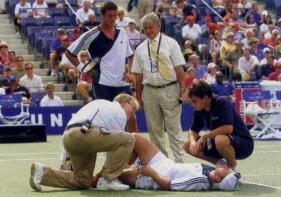 round thriller 6-3, 4-6, 4-6, 6-4, 7-6(4) on Arthur Ashe. “How was I feeling? Dead. Completely dead,” the Russian said. “I was choking so badly. I was embarrassed. I couldn’t serve, I couldn’t play, I couldn’t move.” Still, he and Kiefer managed to stay on court until the bitter (for Kiefer) end, quite an accomplishment so far at the Open. Seven men have quit during first-round matches, a record for a Grand Slam tournament. “All the players are praying not to get injured. Any small injuries – even a finger, or some small muscles you don’t even know about – can bring you trouble,” said Safin, who withdrew from a tournament in Indianapolis this month because of injured ribs. “Tennis is getting a little bit more powerful. We’re playing much faster. That’s why the body breaks.” In the amazing 5th set, Kiefer saved six break points to level at 2-all, then Safin won to ‘love’ his serve, and since 3:2 for him, there were four consecutive breaks of serve. At 5-all Safin saved a mini-match point when Kiefer netted slice backhand. In the 12th game, the German suffering cramps, saved two match points rushing the net. At 6:3 for Safin in the tie-break, Kiefer fell on the court and needed a treatment. When he picked up, he managed to save the third match point with a service winner, but succumbed on fourth. 5th set tie-break was required also in a Latin battle between Tommy Robredo and Mariano Zabaleta; the Spaniard won 6-2, 6-7(3), 7-5, 4-6, 7-6(5) in 4 hours 19
round thriller 6-3, 4-6, 4-6, 6-4, 7-6(4) on Arthur Ashe. “How was I feeling? Dead. Completely dead,” the Russian said. “I was choking so badly. I was embarrassed. I couldn’t serve, I couldn’t play, I couldn’t move.” Still, he and Kiefer managed to stay on court until the bitter (for Kiefer) end, quite an accomplishment so far at the Open. Seven men have quit during first-round matches, a record for a Grand Slam tournament. “All the players are praying not to get injured. Any small injuries – even a finger, or some small muscles you don’t even know about – can bring you trouble,” said Safin, who withdrew from a tournament in Indianapolis this month because of injured ribs. “Tennis is getting a little bit more powerful. We’re playing much faster. That’s why the body breaks.” In the amazing 5th set, Kiefer saved six break points to level at 2-all, then Safin won to ‘love’ his serve, and since 3:2 for him, there were four consecutive breaks of serve. At 5-all Safin saved a mini-match point when Kiefer netted slice backhand. In the 12th game, the German suffering cramps, saved two match points rushing the net. At 6:3 for Safin in the tie-break, Kiefer fell on the court and needed a treatment. When he picked up, he managed to save the third match point with a service winner, but succumbed on fourth. 5th set tie-break was required also in a Latin battle between Tommy Robredo and Mariano Zabaleta; the Spaniard won 6-2, 6-7(3), 7-5, 4-6, 7-6(5) in 4 hours 19 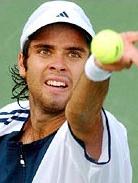 minutes (Robredo won just one point more: 183-182). Two Chilean players (Nicolas Massu & Fernando Gonzalez) prevailed dramatic encounters. Massu struggled past Nicolas Lapentti 6-4, 6-3, 6-7(8), 7-5 in 3 hours 59 minutes. Lapantti won the 3rd set despite a *2:5 deficit saving three match points in the process, and led *5:1 in the 4th set! Gonzalez fired 24 aces during his 2-6, 7-6(1), 3-6, 6-4, 6-4 win over Paul-Henri Mathieu in 190 minutes. One week before, the 20-year-old Frenchman stunned Sampras at Long Island. Among Tuesday’s victims was 1998 finalist Mark Philippoussis, who wrenched his long-troubled left knee in the 4th set against No. 24 Sjeng Schalken and had to stop four games later. Philippoussis was leading 2-1 in sets, and was 5:3 down in the fourth. Defending men’s champion Lleyton Hewitt had a very matter-of-fact debut, beating Nicolas Coutelot of France 6-2, 6-3, 6-3. Hewitt rode 14 aces to victory on Tuesday. However – as has been the case recently – Hewitt made more news off the court just after his match concluded. Hewitt stoked his row with the organizers of professional men’s tennis on Tuesday by branding the ATP liars.
minutes (Robredo won just one point more: 183-182). Two Chilean players (Nicolas Massu & Fernando Gonzalez) prevailed dramatic encounters. Massu struggled past Nicolas Lapentti 6-4, 6-3, 6-7(8), 7-5 in 3 hours 59 minutes. Lapantti won the 3rd set despite a *2:5 deficit saving three match points in the process, and led *5:1 in the 4th set! Gonzalez fired 24 aces during his 2-6, 7-6(1), 3-6, 6-4, 6-4 win over Paul-Henri Mathieu in 190 minutes. One week before, the 20-year-old Frenchman stunned Sampras at Long Island. Among Tuesday’s victims was 1998 finalist Mark Philippoussis, who wrenched his long-troubled left knee in the 4th set against No. 24 Sjeng Schalken and had to stop four games later. Philippoussis was leading 2-1 in sets, and was 5:3 down in the fourth. Defending men’s champion Lleyton Hewitt had a very matter-of-fact debut, beating Nicolas Coutelot of France 6-2, 6-3, 6-3. Hewitt rode 14 aces to victory on Tuesday. However – as has been the case recently – Hewitt made more news off the court just after his match concluded. Hewitt stoked his row with the organizers of professional men’s tennis on Tuesday by branding the ATP liars.
Second round: Christopher Clarey
If you were watching James Blake win his match yesterday at the United States Open, you needed only to walk 30 paces to watch Lleyton Hewitt win his match, too. All that separates the Grandstand and the Louis Armstrong Stadium is a narrow walkway. But no pacing will be required to watch Blake and Hewitt in the third round. They will face each other, just as they did a year ago  in the first week of the United States Open in a terrific match that descended into a diplomatic incident when Hewitt lashed out at an African-American linesman, making a comment that was construed to have racist overtones. Blake gave his Australian opponent the benefit of the doubt. ”We put it behind us the next day in the locker room; since then I don’t think we’ve really talked about it,” he said last night after his 6-3, 4-6, 6-1, 6-3 victory over Nikolai Davydenko of Russia. ‘‘I don’t think about it at all,” Hewitt said after his 7-6(7), 6-4, 6-1 victory over the Israeli qualifier Noam Okun. ”James and I were fine about it. We spoke straight after the situation, and that was pretty much the end of it. I’ve played James twice since then. We’re not the best of mates I guess off the court, just because we’re from different countries. But we’re as close as we can be.” Against Okun, Hewitt had troubles in the 1st set: broken at 5-all, then trailing 2:4, 5:6 & 6:7. Marat Safin did little to slow the transformation. In a match-up that, judging by names and accomplishments alone, belongs in the latter stages of a major tournament rather than merely the second round, Gustavo Kuerten dominated No. 2-seeded Safin 6-4, 6-4, 7-5 Friday at the U.S. Open. “Maybe today is my happiest day of the year,” three-time French Open champion Kuerten said, his disposition as bright as his orange T-shirt, “I feel much more relieved. I feel I have nothing to lose. Winning the match, I got my confidence back. I feel happy with myself and my game.” That hasn’t been the case for much of 2002, a season interrupted in February by right hip surgery that kept him off tour for two months. Kuerten came into the U.S. Open toting a 13-10 match record and a ranking of 46th – making him the first player in 31 years to go from being seeded No. 1 at the Open one year to being unseeded the next. “He’s hungry,” Safin said. “He wants to come back. He wants to win matches.” So does the man Safin upset in the 2000 Open final, Pete Sampras. The 13-time major champion is without a title of any sort since July 2000, but played about as well as he has all season in a 6-3, 7-5, 6-4 victory over Kristian Pless. Sampras had 21 aces, including one at 135 mph to end the match. “It’s been a struggle this year, but hopefully I can get it going here,” said Sampras, 18-0 in night matches at the Open, which he’s won four times. “I feel really comfortable
in the first week of the United States Open in a terrific match that descended into a diplomatic incident when Hewitt lashed out at an African-American linesman, making a comment that was construed to have racist overtones. Blake gave his Australian opponent the benefit of the doubt. ”We put it behind us the next day in the locker room; since then I don’t think we’ve really talked about it,” he said last night after his 6-3, 4-6, 6-1, 6-3 victory over Nikolai Davydenko of Russia. ‘‘I don’t think about it at all,” Hewitt said after his 7-6(7), 6-4, 6-1 victory over the Israeli qualifier Noam Okun. ”James and I were fine about it. We spoke straight after the situation, and that was pretty much the end of it. I’ve played James twice since then. We’re not the best of mates I guess off the court, just because we’re from different countries. But we’re as close as we can be.” Against Okun, Hewitt had troubles in the 1st set: broken at 5-all, then trailing 2:4, 5:6 & 6:7. Marat Safin did little to slow the transformation. In a match-up that, judging by names and accomplishments alone, belongs in the latter stages of a major tournament rather than merely the second round, Gustavo Kuerten dominated No. 2-seeded Safin 6-4, 6-4, 7-5 Friday at the U.S. Open. “Maybe today is my happiest day of the year,” three-time French Open champion Kuerten said, his disposition as bright as his orange T-shirt, “I feel much more relieved. I feel I have nothing to lose. Winning the match, I got my confidence back. I feel happy with myself and my game.” That hasn’t been the case for much of 2002, a season interrupted in February by right hip surgery that kept him off tour for two months. Kuerten came into the U.S. Open toting a 13-10 match record and a ranking of 46th – making him the first player in 31 years to go from being seeded No. 1 at the Open one year to being unseeded the next. “He’s hungry,” Safin said. “He wants to come back. He wants to win matches.” So does the man Safin upset in the 2000 Open final, Pete Sampras. The 13-time major champion is without a title of any sort since July 2000, but played about as well as he has all season in a 6-3, 7-5, 6-4 victory over Kristian Pless. Sampras had 21 aces, including one at 135 mph to end the match. “It’s been a struggle this year, but hopefully I can get it going here,” said Sampras, 18-0 in night matches at the Open, which he’s won four times. “I feel really comfortable 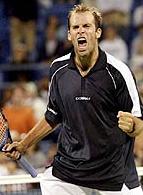 playing here.” His next opponent is 1997 runner-up Greg Rusedski, who edged Paradorn Srichaphan 3-6, 7-6(2), 7-6(5), 6-7(3), 6-4 in 3 hours 49 minutes In the 2nd-set tie-breaker, Srichaphan never recovered from a netted forehand on the third point. In the 3rd-set tie-breaker, he made three straight forehand cross-court winners to take a 4:2* lead. Then, leading *5:3, he tightened perceptibly and floated a nervous backhand into the net. Rusedski closed him out with a forehand cross-court winner when Srichaphan went the wrong way. By now, with the Sampras-Pless match over, the Armstrong crowd, growing more raucous by the minute, began to swell. Srichaphan almost went out when he was serving to level the 4th set at 5-all. Rusedski squeezed him to 30-all – a point away from match point – but Srichaphan produced a bold forehand pass and a successful overhead to send the match lurching into its third straight tie-breaker. This time, Srichaphan was up to it. At 2-all, Rusedski gave him a gift – a double-fault – and Srichaphan went on to level the match. In the 5th set, Srichaphan finally gave in to his nerves. He was broken to open the set and with Rusedski holding a break point in the third game, Srichaphan double-faulted to go down 0:4. Rusedski, baring his teeth and tugging on his socks with a trademark service ritual, almost lost the advantage of two breaks – he escaped from 15/40 (serving to win the match at 5:4) with an ace and backhand volley. Srichaphan will be involved in another 5-setter with three tie-breaks in New York (2005, losing to Davide Sanguinetti). Next up is Sampras, to whom Rusedski has lost eight of nine career matches. Is he concerned that Sampras will come into Sunday’s match with two easy three-set wins? “I’m in the best shape of my life,” Rusedski said. “Obviously, it helps Pete a little bit. He’ll be favored so I have nothing to lose.” Also into the third round was No. 11 Andy Roddick, who turned 20 Friday and was serenaded with “Happy Birthday” by fans en route to his tour-leading 50th match victory this year. But 10th-seeded Sebastien Grosjean lost to fellow Frenchman Arnaud Clement 6-3, 3-6,
playing here.” His next opponent is 1997 runner-up Greg Rusedski, who edged Paradorn Srichaphan 3-6, 7-6(2), 7-6(5), 6-7(3), 6-4 in 3 hours 49 minutes In the 2nd-set tie-breaker, Srichaphan never recovered from a netted forehand on the third point. In the 3rd-set tie-breaker, he made three straight forehand cross-court winners to take a 4:2* lead. Then, leading *5:3, he tightened perceptibly and floated a nervous backhand into the net. Rusedski closed him out with a forehand cross-court winner when Srichaphan went the wrong way. By now, with the Sampras-Pless match over, the Armstrong crowd, growing more raucous by the minute, began to swell. Srichaphan almost went out when he was serving to level the 4th set at 5-all. Rusedski squeezed him to 30-all – a point away from match point – but Srichaphan produced a bold forehand pass and a successful overhead to send the match lurching into its third straight tie-breaker. This time, Srichaphan was up to it. At 2-all, Rusedski gave him a gift – a double-fault – and Srichaphan went on to level the match. In the 5th set, Srichaphan finally gave in to his nerves. He was broken to open the set and with Rusedski holding a break point in the third game, Srichaphan double-faulted to go down 0:4. Rusedski, baring his teeth and tugging on his socks with a trademark service ritual, almost lost the advantage of two breaks – he escaped from 15/40 (serving to win the match at 5:4) with an ace and backhand volley. Srichaphan will be involved in another 5-setter with three tie-breaks in New York (2005, losing to Davide Sanguinetti). Next up is Sampras, to whom Rusedski has lost eight of nine career matches. Is he concerned that Sampras will come into Sunday’s match with two easy three-set wins? “I’m in the best shape of my life,” Rusedski said. “Obviously, it helps Pete a little bit. He’ll be favored so I have nothing to lose.” Also into the third round was No. 11 Andy Roddick, who turned 20 Friday and was serenaded with “Happy Birthday” by fans en route to his tour-leading 50th match victory this year. But 10th-seeded Sebastien Grosjean lost to fellow Frenchman Arnaud Clement 6-3, 3-6, 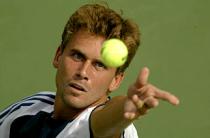 4-6, 6-2, 6-4 – it was their second 5-set encounter, and Clement survived both matches. The man nicknamed “Hollywood” tore up the script on Thursday – Jan-Michael Gambill buried No. 9 Carlos Moya 6-3, 6-3, 6-1 to storm into the third round of the U.S. Open in front of a thrilled New York night crowd. The American, who has struggled with injury for the better part of a year, had never beaten Moya in three previous occasions and had failed to pass the second round of a Grand Slam since the start of 2001. In his past seven majors, Gambill has lost in the first round on five occasions. But against the Spaniard, he moved and fought like the top 20 player he was last year. “If I can keep playing like this, I am going to do well here,” he said after wrapping up a 94-minute victory. “The crowd was great, the atmosphere was electric.” Former world No. 1 Jim Courier, now a television commentator and pundit, coined Gambill’s nickname because of the young man’s good looks and sideline in modeling. But on Thursday, the 25-year-old showed there is also plenty beneath the surface. Moya came to the U.S. Open on a roll. The former world No. 1 lifted the title in his last tournament in Cincinnati, where he beat defending U.S. Open champion Hewitt in the final. But Gambill ripped into him from the start, firing his idiosyncratic two-fisted forehand into the corners and serving with power and accuracy. He raced through the 1st set in 26 minutes and never looked back on a floodlit Arthur Ashe stadium court. Tommy Haas, choosing not to challenge the United States Tennis Association’s ban on sleeveless shirts which caused a stir earlier in the week, defeated Karol Kucera 6-1, 6-4, 6-4. Wearing a conventional tennis shirt and with his hat sitting backward over his ponytail, Haas was a comfortable winner over Kucera, who has been troubled by injuries to his right wrist and knee the last two years. Haas already led 4:0*
4-6, 6-2, 6-4 – it was their second 5-set encounter, and Clement survived both matches. The man nicknamed “Hollywood” tore up the script on Thursday – Jan-Michael Gambill buried No. 9 Carlos Moya 6-3, 6-3, 6-1 to storm into the third round of the U.S. Open in front of a thrilled New York night crowd. The American, who has struggled with injury for the better part of a year, had never beaten Moya in three previous occasions and had failed to pass the second round of a Grand Slam since the start of 2001. In his past seven majors, Gambill has lost in the first round on five occasions. But against the Spaniard, he moved and fought like the top 20 player he was last year. “If I can keep playing like this, I am going to do well here,” he said after wrapping up a 94-minute victory. “The crowd was great, the atmosphere was electric.” Former world No. 1 Jim Courier, now a television commentator and pundit, coined Gambill’s nickname because of the young man’s good looks and sideline in modeling. But on Thursday, the 25-year-old showed there is also plenty beneath the surface. Moya came to the U.S. Open on a roll. The former world No. 1 lifted the title in his last tournament in Cincinnati, where he beat defending U.S. Open champion Hewitt in the final. But Gambill ripped into him from the start, firing his idiosyncratic two-fisted forehand into the corners and serving with power and accuracy. He raced through the 1st set in 26 minutes and never looked back on a floodlit Arthur Ashe stadium court. Tommy Haas, choosing not to challenge the United States Tennis Association’s ban on sleeveless shirts which caused a stir earlier in the week, defeated Karol Kucera 6-1, 6-4, 6-4. Wearing a conventional tennis shirt and with his hat sitting backward over his ponytail, Haas was a comfortable winner over Kucera, who has been troubled by injuries to his right wrist and knee the last two years. Haas already led 4:0*  (30/15) in the 3rd set, then was forced to save three break points in the 10th game. Wayne Ferreira won second dramatic five-setter over Albert Costa in 2002. During the Australian Open, the South African prevailed 9-7 in fifth in more than four hours (served 26 aces); this time 1-6, 6-7(10), 6-4, 7-5, 6-4 under four hours (served 21 aces). Early in their careers, Dominik Hrbaty had hounded Yevgeny Kafelnikov, winning seven of their first eight meetings. But the Russian seemed to have reversed that trend by winning their last three meetings. Suddenly, their fortunes turned again, Hrbaty winning easily 6-3, 6-1, 6-1. Kafelnikov, a semifinalist at the Open two of the last three years, was devastated. What went wrong, he was asked. “A very exact question I am asking myself,” he said. “There is no answer for that, unfortunately.” Good manners were the order of the day on Thursday. Andre Agassi demolished his countryman Justin Gimelstob 6-0, 6-1, 6-1, prompting the legendary tennis writer, Bud Collins, to suggest that such play was positively anti-American. Rainer Schuettler after winning two opening sets (6-3, 7-6) against Jean-Rene Lisnard, led 4:2 in the 3rd set when an injury started to bother him. The German lost eight games in a row, and decided to retire at 0:4 in the 4th set.
(30/15) in the 3rd set, then was forced to save three break points in the 10th game. Wayne Ferreira won second dramatic five-setter over Albert Costa in 2002. During the Australian Open, the South African prevailed 9-7 in fifth in more than four hours (served 26 aces); this time 1-6, 6-7(10), 6-4, 7-5, 6-4 under four hours (served 21 aces). Early in their careers, Dominik Hrbaty had hounded Yevgeny Kafelnikov, winning seven of their first eight meetings. But the Russian seemed to have reversed that trend by winning their last three meetings. Suddenly, their fortunes turned again, Hrbaty winning easily 6-3, 6-1, 6-1. Kafelnikov, a semifinalist at the Open two of the last three years, was devastated. What went wrong, he was asked. “A very exact question I am asking myself,” he said. “There is no answer for that, unfortunately.” Good manners were the order of the day on Thursday. Andre Agassi demolished his countryman Justin Gimelstob 6-0, 6-1, 6-1, prompting the legendary tennis writer, Bud Collins, to suggest that such play was positively anti-American. Rainer Schuettler after winning two opening sets (6-3, 7-6) against Jean-Rene Lisnard, led 4:2 in the 3rd set when an injury started to bother him. The German lost eight games in a row, and decided to retire at 0:4 in the 4th set.
Third round: (CNN)
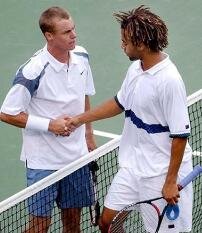 James Blake did what he could to the wash away the ill will directed at Lleyton Hewitt by some spectators during a riveting U.S. Open rematch. Blake had a tougher time withstanding the defending champion’s relentless play. His sneakers squeaking with each step, his darting eyes finding the right angles, Hewitt got past Blake 6-7(5), 6-3, 6-4, 3-6, 6-3 Saturday to reach the fourth round. It came a year to the day after another five-setter between the pair, one marked by a call-arguing tirade by Hewitt that was perceived as racist. Saturday’s “was a great match for the sport. We fought our hearts out. He came up with great shots, I came up with great shots. He came up with a few more,” Blake said after playing in the third round of a major for the first time. “The way we conducted ourselves – I really like the fact that if any kid was watching, they could say, ‘I want to be like either one of those two.”‘ In the 1st set Hewitt had three mini-set points in the 11th game and led 5:2* in the tie-break. The Australian broke for the first time after six ‘deuces’ leading 3:2 in the 2nd set. A tight match came down to Blake’s three-point lapse in the 6th game of the last set. Blake made three straight errors (he had 86 total to Hewitt’s 40), Hewitt snapped a forehand winner, and just like that, the No. 1-seeded Australian had a 4:2 lead. “To see us not give an inch the whole match for 3 1/2 hours – it’s something we can both be proud of,” Hewitt said. Unlike last year, there were no prolonged protests about the officiating. Blake just shook his head when a scoreboard replay showed a shot of his that was called out but actually hit the line. Both players applauded great shots by the other, of which there were plenty: 113 winners, 60 by Blake, despite strong winds, occasional rain and a cloud cover that made it so dark the stadium lights were switched on at about 3 p.m. The only boorish behavior came from the stands. There was cheering after faults by Hewitt – Blake waved his hand, indicating he didn’t want that type of support – and in the 4th set, someone in the crowd yelled: “James, don’t let him win. He’s a racist.” When Hewitt closed the thriller with his 15th ace, the players met at the net to shake hands. Blake told the Wimbledon champion, “You played great, man,” and apologized for the fans that were speaking out negatively. “That’s something that I was somewhat embarrassed by, when a few fans did that,” said the 25th-seeded Blake, whose rapidly improving game produced his first title two weeks ago in Washington. Hewitt, who said he didn’t notice what the fans were saying, next plays No. 14 Jiri Novak. He advanced when Marcelo Rios quit after losing the first two sets ‘3-6’, citing a right knee injury and raising the number of retirements to a Grand Slam-record nine men. Also into the fourth round is two-time champion Andre Agassi, who beat Ramon Delgado 6-2, 6-1, 6-2 and has dropped 16 games so far. Agassi now faces Jan-Michael Gambill, who demolished No. 21 Gaston Gaudio 6-0, 6-2, 6-0 in 84 minutes. Pete Sampras unfurled a backhand return winner down the line and let out an excited yell: “Aaahhh!” The fans responded, applauding and chanting support. It was tough to tell who was
James Blake did what he could to the wash away the ill will directed at Lleyton Hewitt by some spectators during a riveting U.S. Open rematch. Blake had a tougher time withstanding the defending champion’s relentless play. His sneakers squeaking with each step, his darting eyes finding the right angles, Hewitt got past Blake 6-7(5), 6-3, 6-4, 3-6, 6-3 Saturday to reach the fourth round. It came a year to the day after another five-setter between the pair, one marked by a call-arguing tirade by Hewitt that was perceived as racist. Saturday’s “was a great match for the sport. We fought our hearts out. He came up with great shots, I came up with great shots. He came up with a few more,” Blake said after playing in the third round of a major for the first time. “The way we conducted ourselves – I really like the fact that if any kid was watching, they could say, ‘I want to be like either one of those two.”‘ In the 1st set Hewitt had three mini-set points in the 11th game and led 5:2* in the tie-break. The Australian broke for the first time after six ‘deuces’ leading 3:2 in the 2nd set. A tight match came down to Blake’s three-point lapse in the 6th game of the last set. Blake made three straight errors (he had 86 total to Hewitt’s 40), Hewitt snapped a forehand winner, and just like that, the No. 1-seeded Australian had a 4:2 lead. “To see us not give an inch the whole match for 3 1/2 hours – it’s something we can both be proud of,” Hewitt said. Unlike last year, there were no prolonged protests about the officiating. Blake just shook his head when a scoreboard replay showed a shot of his that was called out but actually hit the line. Both players applauded great shots by the other, of which there were plenty: 113 winners, 60 by Blake, despite strong winds, occasional rain and a cloud cover that made it so dark the stadium lights were switched on at about 3 p.m. The only boorish behavior came from the stands. There was cheering after faults by Hewitt – Blake waved his hand, indicating he didn’t want that type of support – and in the 4th set, someone in the crowd yelled: “James, don’t let him win. He’s a racist.” When Hewitt closed the thriller with his 15th ace, the players met at the net to shake hands. Blake told the Wimbledon champion, “You played great, man,” and apologized for the fans that were speaking out negatively. “That’s something that I was somewhat embarrassed by, when a few fans did that,” said the 25th-seeded Blake, whose rapidly improving game produced his first title two weeks ago in Washington. Hewitt, who said he didn’t notice what the fans were saying, next plays No. 14 Jiri Novak. He advanced when Marcelo Rios quit after losing the first two sets ‘3-6’, citing a right knee injury and raising the number of retirements to a Grand Slam-record nine men. Also into the fourth round is two-time champion Andre Agassi, who beat Ramon Delgado 6-2, 6-1, 6-2 and has dropped 16 games so far. Agassi now faces Jan-Michael Gambill, who demolished No. 21 Gaston Gaudio 6-0, 6-2, 6-0 in 84 minutes. Pete Sampras unfurled a backhand return winner down the line and let out an excited yell: “Aaahhh!” The fans responded, applauding and chanting support. It was tough to tell who was 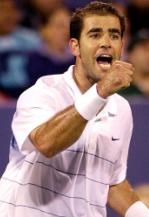 more pleased to see Sampras hit that kind of shot again. Playing in the tournament that’s brought out his best during the past two difficult years, Sampras powered into the fourth round by overcoming Greg Rusedski 7-6(4), 4-6, 7-6(3), 3-6, 6-4 in 3 hours 22 minutes Monday night at a U.S. Open disrupted heavily by rain (on Sunday their match was suspended in the 10th game after Sampras saved two set points returning at 3:5). “I hung in there. The crowd was great. It got me going at the end,” said Sampras, who had 81 winners and broke 1997 Open runner-up Rusedski’s serve in the final game of the match: “It made it a little sweeter with the win. As you get older, those are moments you cherish a little more.” Rusedski was hardly charitable in defeat. “He’s a step and a half slow coming into the net. He’s just not the same player,” Rusedski said. “I lost the match. He didn’t win the match tonight. He’s not playing that great. I’ll be surprised if he wins his next match, to be honest with you.” Sampras, seeded just 17th, next plays No. 3 Tommy Haas – the man who wasn’t allowed to wear his muscle shirt at the Open – for a quarterfinal berth. Haas survived a scare against Thomas Enqvist on Grandstand 6-4, 3-6, 3-6, 6-4, 6-4. The German already led 4:0* (40/0) in the 5th set. Defending champion Hewitt and two-time Open winner Agassi already are in the final eight. The 11th-seeded Andy Roddick beat No. 18 Alex Corretja 6-4, 6-1, 7-6(6) in a match that ended with a 41-stroke point decided by Roddick’s forehand winner. The fifth-seeded Tim Henman was beaten by 26th-seeded Juan Ignacio Chela of Argentina 6-3, 6-3, 6-2 in
more pleased to see Sampras hit that kind of shot again. Playing in the tournament that’s brought out his best during the past two difficult years, Sampras powered into the fourth round by overcoming Greg Rusedski 7-6(4), 4-6, 7-6(3), 3-6, 6-4 in 3 hours 22 minutes Monday night at a U.S. Open disrupted heavily by rain (on Sunday their match was suspended in the 10th game after Sampras saved two set points returning at 3:5). “I hung in there. The crowd was great. It got me going at the end,” said Sampras, who had 81 winners and broke 1997 Open runner-up Rusedski’s serve in the final game of the match: “It made it a little sweeter with the win. As you get older, those are moments you cherish a little more.” Rusedski was hardly charitable in defeat. “He’s a step and a half slow coming into the net. He’s just not the same player,” Rusedski said. “I lost the match. He didn’t win the match tonight. He’s not playing that great. I’ll be surprised if he wins his next match, to be honest with you.” Sampras, seeded just 17th, next plays No. 3 Tommy Haas – the man who wasn’t allowed to wear his muscle shirt at the Open – for a quarterfinal berth. Haas survived a scare against Thomas Enqvist on Grandstand 6-4, 3-6, 3-6, 6-4, 6-4. The German already led 4:0* (40/0) in the 5th set. Defending champion Hewitt and two-time Open winner Agassi already are in the final eight. The 11th-seeded Andy Roddick beat No. 18 Alex Corretja 6-4, 6-1, 7-6(6) in a match that ended with a 41-stroke point decided by Roddick’s forehand winner. The fifth-seeded Tim Henman was beaten by 26th-seeded Juan Ignacio Chela of Argentina 6-3, 6-3, 6-2 in 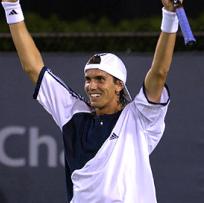 the third round Monday. The contest was rained out Sunday. Henman, who owns one of the top pure serve-and-volley games on tour, never seemed to get on track against his Chela, failing to convert any of his five break-point opportunities. Chela was 5-for-9 in the match, which lasted 1 hour, 49 minutes. Henman said afterwards that his shoulder trouble contributed heavily to his tame performance. “Any sort of upward movement is when I get the impingement.” But he added: “I think he played very, very well. I didn’t give myself much of a chance under the circumstances.” Henman committed 42 unforced errors on one of Flushing Meadows’ outside courts. And his confident opponent took full advantage, holding serve with ease and punishing Henman’s delivery, which noticeably lacked pace and precision.
the third round Monday. The contest was rained out Sunday. Henman, who owns one of the top pure serve-and-volley games on tour, never seemed to get on track against his Chela, failing to convert any of his five break-point opportunities. Chela was 5-for-9 in the match, which lasted 1 hour, 49 minutes. Henman said afterwards that his shoulder trouble contributed heavily to his tame performance. “Any sort of upward movement is when I get the impingement.” But he added: “I think he played very, very well. I didn’t give myself much of a chance under the circumstances.” Henman committed 42 unforced errors on one of Flushing Meadows’ outside courts. And his confident opponent took full advantage, holding serve with ease and punishing Henman’s delivery, which noticeably lacked pace and precision.
Fourth round: (CNN)
A sweat-soaked Pete Sampras seemed barely able to muster the strength to wave to the crowd after his victory. Just hours earlier, on another court, Roddick packed a match’s worth of athleticism and emotion into one sequence. Sampras and Roddick, at opposite ends of their careers, both won Tuesday night to set up a showdown in the U.S. Open quarterfinals. The 31-year-old Sampras powered 27 aces, was aided by his opponent’s late double faults, and got past third-seeded Tommy Haas in 3 hours 2 minutes, 7-5, 6-4, 6-7(5), 7-5. Sampras had lost three straight matches to Haas, and all on hardcourts. It was Sampras’ 200th Grand Slam tournament match victory. “It was a long night. I was feeling it a little bit at the end. It’s pretty humid out here,” said Sampras, without a title since July 2000. “They’re big matches, especially the year that I’ve 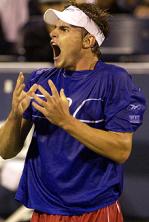 had. It’s been a little bit frustrating, but I’ve still got the game.” Haas was two points away from taking the 1st set at 5:4* (30-all); in the 10th game of the 2nd set Haas had his only break point in the match after Sampras had squandered four set points. “This past week and a half, I feel like I have kind of got my game going. I’m comfortable playing here,” said Sampras, who entered with a 20-17 match record in 2002. Asked about Rusedski’s statement, Sampras smiled. “I don’t really worry about what he says. Against him, I don’t really need to be a step and a half quicker.” Playing on a heavily taped bruised left foot, the 11th-seeded Andy Roddick reached the Open’s final eight for the second straight year with a 5-7, 6-4, 6-4, 6-4 victory over No. 26 Juan Ignacio Chela of Argentina. The Argentine led *2:0 (30-all) in the 2nd set. “It’s kind of the generations overlapping,” said Roddick, who turned 20 Friday. “I grew up idolizing him. I have a great deal of respect for Pete and what he’s done. Having said that, I want to go out there and play some ball.” For better or worse, Roddick was the picture of youthful exuberance against Chela. Fernando Gonzalez of Chile reached the quarterfinals at the U.S. Open on Tuesday, knocking out unseeded Arnaud Clement of France 6-4, 6-2, 6-3 in the fourth round. Gonzalez, the world No. 28, upset seventh-seeded Juan Carlos
had. It’s been a little bit frustrating, but I’ve still got the game.” Haas was two points away from taking the 1st set at 5:4* (30-all); in the 10th game of the 2nd set Haas had his only break point in the match after Sampras had squandered four set points. “This past week and a half, I feel like I have kind of got my game going. I’m comfortable playing here,” said Sampras, who entered with a 20-17 match record in 2002. Asked about Rusedski’s statement, Sampras smiled. “I don’t really worry about what he says. Against him, I don’t really need to be a step and a half quicker.” Playing on a heavily taped bruised left foot, the 11th-seeded Andy Roddick reached the Open’s final eight for the second straight year with a 5-7, 6-4, 6-4, 6-4 victory over No. 26 Juan Ignacio Chela of Argentina. The Argentine led *2:0 (30-all) in the 2nd set. “It’s kind of the generations overlapping,” said Roddick, who turned 20 Friday. “I grew up idolizing him. I have a great deal of respect for Pete and what he’s done. Having said that, I want to go out there and play some ball.” For better or worse, Roddick was the picture of youthful exuberance against Chela. Fernando Gonzalez of Chile reached the quarterfinals at the U.S. Open on Tuesday, knocking out unseeded Arnaud Clement of France 6-4, 6-2, 6-3 in the fourth round. Gonzalez, the world No. 28, upset seventh-seeded Juan Carlos 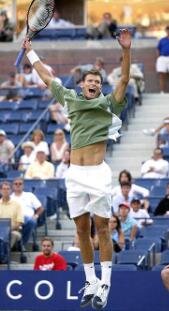 Ferrero of Spain in the third round 6-4, 6-4, 6-4. Clement, ranked 43rd in the world, upset 10th-seeded countryman Grosjean in the second round and topped Coria of Argentina in the third round. The 28th-seeded Gonzalez will meet Sjeng Schalken of the Netherlands in the quarterfinals. Schalken, seeded 24th, topped former world No. 1 Gustavo Kuerten of Brazil 6-3, 7-6(6), 6-7(5), 7-6(4) earlier Tuesday. Kuerten, a three-time French Open champion, was unseeded because of poor results relating to his injury and subsequent surgery. The Brazilian, who has reached the quarterfinals at the U.S. Open twice before, upset second-seeded Safin – the winner here two years ago – in the second round. Kuerten wasn’t expected to even make it this far in the year’s final major tournament, having been the first man in 31 years to go from being seeded No. 1 at the U.S. Open one year to being unseeded the next. He entered the Open with a 12-10 match record in 2002, a season interrupted in February by right hip surgery that kept him off the tour for two months and led to a drop to 46th in the rankings. Schalken, meanwhile, reached the quarterfinals at a second straight Grand Slam event after never having been that far in the first 28 majors of his career. Schalken after winning 1st set easily, led 4:2* in the 2nd when the match turned into a dramatic 4-setter. ‘Guga’ broke back and led 5:3 & *6:5 in the tie-break. In the 3rd set Schalken was two points away from a straight sets victory at 5:4 & 6:5, in the tie-break saved two set points, then failed to save the third one. Kuerten led 5:4 (30/15) in the 4th set when the Dutchman played an excellent overhead. Lleyton Hewitt eliminated No. 14 Jiri Novak 6-4, 6-2, 7-5. No. 32 Max Mirnyi dismissed Roger Federer 6-3, 7-6(5), 6-4. In some respects, it had the feel of two pals out for a late-night hitting session under the lights. There was much more at stake, of course, when Younes El Aynaoui and Wayne Ferreira played until 2:14 a.m on Tuesday: money, ranking points, and a berth in the U.S.
Ferrero of Spain in the third round 6-4, 6-4, 6-4. Clement, ranked 43rd in the world, upset 10th-seeded countryman Grosjean in the second round and topped Coria of Argentina in the third round. The 28th-seeded Gonzalez will meet Sjeng Schalken of the Netherlands in the quarterfinals. Schalken, seeded 24th, topped former world No. 1 Gustavo Kuerten of Brazil 6-3, 7-6(6), 6-7(5), 7-6(4) earlier Tuesday. Kuerten, a three-time French Open champion, was unseeded because of poor results relating to his injury and subsequent surgery. The Brazilian, who has reached the quarterfinals at the U.S. Open twice before, upset second-seeded Safin – the winner here two years ago – in the second round. Kuerten wasn’t expected to even make it this far in the year’s final major tournament, having been the first man in 31 years to go from being seeded No. 1 at the U.S. Open one year to being unseeded the next. He entered the Open with a 12-10 match record in 2002, a season interrupted in February by right hip surgery that kept him off the tour for two months and led to a drop to 46th in the rankings. Schalken, meanwhile, reached the quarterfinals at a second straight Grand Slam event after never having been that far in the first 28 majors of his career. Schalken after winning 1st set easily, led 4:2* in the 2nd when the match turned into a dramatic 4-setter. ‘Guga’ broke back and led 5:3 & *6:5 in the tie-break. In the 3rd set Schalken was two points away from a straight sets victory at 5:4 & 6:5, in the tie-break saved two set points, then failed to save the third one. Kuerten led 5:4 (30/15) in the 4th set when the Dutchman played an excellent overhead. Lleyton Hewitt eliminated No. 14 Jiri Novak 6-4, 6-2, 7-5. No. 32 Max Mirnyi dismissed Roger Federer 6-3, 7-6(5), 6-4. In some respects, it had the feel of two pals out for a late-night hitting session under the lights. There was much more at stake, of course, when Younes El Aynaoui and Wayne Ferreira played until 2:14 a.m on Tuesday: money, ranking points, and a berth in the U.S. 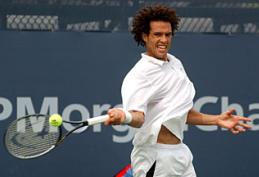 Open quarterfinals against defending champion Hewitt. El Aynaoui, a Moroccan seeded 20th, beat the South African 3-6, 7-5, 7-5, 7-6(3), with about 300 fans sticking around until the final point. The finishing time was just 12 minutes short of the U.S. Open’s record for latest end to a match. On Sept. 4, 1993, Mats Wilander‘s victory over fellow Swede Mikael Pernfors ended at 2:26 a.m. The late-night show starring El Aynaoui and Ferreira was the conclusion to a long session of tennis as play didn’t get going on Monday until after 6 p.m. because of a rain delay of more than seven hours. Earlier, sixth seed Andre Agassi stormed into the quarterfinals with 6-2, 6-3, 6-3 demolition of fellow American Jan-Michael Gambill. Agassi and Gambill had been the two dominant figures during the first week of the season’s final Grand Slam dropping 16 and 11 games respectively on way to their fourth round clash. But once again, Gambill had no answers, as the 32-year-old Agassi, much to the delight of a large crowd, ran his younger opponent around the Arthur Ashe stadium court. The two-time U.S. Open champion needed just 1 hour and 41 minutes to register his sixth consecutive decision over the 25-year-old Gambill and add his name to a growing list of American victims.
Open quarterfinals against defending champion Hewitt. El Aynaoui, a Moroccan seeded 20th, beat the South African 3-6, 7-5, 7-5, 7-6(3), with about 300 fans sticking around until the final point. The finishing time was just 12 minutes short of the U.S. Open’s record for latest end to a match. On Sept. 4, 1993, Mats Wilander‘s victory over fellow Swede Mikael Pernfors ended at 2:26 a.m. The late-night show starring El Aynaoui and Ferreira was the conclusion to a long session of tennis as play didn’t get going on Monday until after 6 p.m. because of a rain delay of more than seven hours. Earlier, sixth seed Andre Agassi stormed into the quarterfinals with 6-2, 6-3, 6-3 demolition of fellow American Jan-Michael Gambill. Agassi and Gambill had been the two dominant figures during the first week of the season’s final Grand Slam dropping 16 and 11 games respectively on way to their fourth round clash. But once again, Gambill had no answers, as the 32-year-old Agassi, much to the delight of a large crowd, ran his younger opponent around the Arthur Ashe stadium court. The two-time U.S. Open champion needed just 1 hour and 41 minutes to register his sixth consecutive decision over the 25-year-old Gambill and add his name to a growing list of American victims.
Quarterfinals: (CNN), Sandra McKee
Soft-serving Sjeng Schalken won Thursday’s quarterfinal, beating Fernando Gonzalez before an all-American glamor match at the U.S. Open. Schalken reached his first semifinal in 30 Grand Slam tournaments with a 6-7(5), 6-3, 6-3, 6-7(5), 7-6(2) win over the Chilean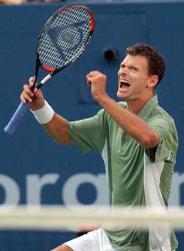 . Their 3-hour, 43-minute match ended about an hour before Pete Sampras‘ straight-set rout of 20-year-old Andy Roddick. Smacking aces at over 130 mph, covering every inch of the net, Sampras looked like the younger man and dominated an apparently awestruck Roddick 6-3, 6-2, 6-4 to reach the U.S. Open semifinals for the eighth time. The profiles of Schalken and Gonzalez are considerably lower. Schalken is seeded 24th and never reached a Grand Slam quarterfinal until he did it on his 29th try this year at Wimbledon, where he was the only player to take a set from champion Hewitt. Gonzalez, seeded 28th, was in his first Grand Slam quarterfinal and bidding to become the first player from Chile to reach the Open semifinals. “I didn’t expect this, to be in the semis,” Schalken said. “I’m now a little bit more relaxed than before the quarterfinals.” Schalken won the match on a breezy day when he finally held on to a big lead in a tiebreaker. He led the first tiebreaker 5:1 and the second 5:3 and lost them both. At 6:5* in the 1st set he wasted a double set point. In the 2nd set Gonzalez led 3:2* (15/30) when lost 14 consecutive points, and a little bit later found himself at *0:3 in the 3rd set. There was no break point in the decider, no ‘deuce’ even once – they served so well. “You have to win one, of course to win the match”, Schalken said. He went ahead 6:0 in the last one before Gonzalez got the next two points. On the next point, Gonzalez returned Schalken’s serve wide, making Schalken the first Dutchman to reach the Open semifinals since Tom Okker in 1971. “I said to myself, ‘Go for it. The first six points you’re with the wind,”‘ he said of the tiebreaker. Schalken won his fifth match in the tournament after winning a total of seven in his previous seven U.S. Opens. But he failed at critical times. He committed his only two double faults of the match in the 4th-set tiebreaker. He matched Gonzalez with 12 aces, but Gonzalez also had 12 double faults. Schalken’s fastest serve was just 110 mph, compared with 130 mpg for Gonzalez. “I don’t have the speed. I don’t have that in my arm,” the 6-foot-3 Schalken said. “I tried that many times, but I get injuries.” The Dutchman improved his poor five-set record to 6-13. “This is what I play for. I was ready to go from the first point on,” said Sampras after destroying his 11 years younger countryman. “I’m just confident in the big
. Their 3-hour, 43-minute match ended about an hour before Pete Sampras‘ straight-set rout of 20-year-old Andy Roddick. Smacking aces at over 130 mph, covering every inch of the net, Sampras looked like the younger man and dominated an apparently awestruck Roddick 6-3, 6-2, 6-4 to reach the U.S. Open semifinals for the eighth time. The profiles of Schalken and Gonzalez are considerably lower. Schalken is seeded 24th and never reached a Grand Slam quarterfinal until he did it on his 29th try this year at Wimbledon, where he was the only player to take a set from champion Hewitt. Gonzalez, seeded 28th, was in his first Grand Slam quarterfinal and bidding to become the first player from Chile to reach the Open semifinals. “I didn’t expect this, to be in the semis,” Schalken said. “I’m now a little bit more relaxed than before the quarterfinals.” Schalken won the match on a breezy day when he finally held on to a big lead in a tiebreaker. He led the first tiebreaker 5:1 and the second 5:3 and lost them both. At 6:5* in the 1st set he wasted a double set point. In the 2nd set Gonzalez led 3:2* (15/30) when lost 14 consecutive points, and a little bit later found himself at *0:3 in the 3rd set. There was no break point in the decider, no ‘deuce’ even once – they served so well. “You have to win one, of course to win the match”, Schalken said. He went ahead 6:0 in the last one before Gonzalez got the next two points. On the next point, Gonzalez returned Schalken’s serve wide, making Schalken the first Dutchman to reach the Open semifinals since Tom Okker in 1971. “I said to myself, ‘Go for it. The first six points you’re with the wind,”‘ he said of the tiebreaker. Schalken won his fifth match in the tournament after winning a total of seven in his previous seven U.S. Opens. But he failed at critical times. He committed his only two double faults of the match in the 4th-set tiebreaker. He matched Gonzalez with 12 aces, but Gonzalez also had 12 double faults. Schalken’s fastest serve was just 110 mph, compared with 130 mpg for Gonzalez. “I don’t have the speed. I don’t have that in my arm,” the 6-foot-3 Schalken said. “I tried that many times, but I get injuries.” The Dutchman improved his poor five-set record to 6-13. “This is what I play for. I was ready to go from the first point on,” said Sampras after destroying his 11 years younger countryman. “I’m just confident in the big  moment that I’m going to come through. I spent moments of struggling with the confidence this year, but I can get it back pretty quickly.” Sampras has played his best tennis of the past 24 months in the U.S. Open, reaching the finals in 2000 and 2001. Now he’s doing it again. “You guys say Pete is washed up. I never said it,” Roddick said. “I don’t think anybody doubts the fact that he’s capable of great tennis still.” Sampras broke early in each of sets leading 3:0, 3:1 & 2:0 respectively, and closed the match out in 89 minutes with a stop-volley. No. 1 seed Lleyton Hewitt seemed to be everywhere on the court. His legs churned with the speed of an antelope running for cover. He got to almost every ball Younes El Aynaoui sent over the net. And he scored at least one point when it was El Aynaoui who appeared to hit a winner. For Hewitt, everything was possible yesterday, as he moved into the U.S. Open semifinals with a 6-1, 7-6(6), 4-6, 6-2 victory in 2 hours 40 minutes. It was the last game of the final set. Hewitt served and El Aynaoui returned a brilliant spinning drop shot. Hewitt, who had already tracked down several of El Aynaoui’s well-delivered dropped volleys, charged from the back of the court. It appeared Hewitt would not reach this ball in time, but, it didn’t matter – the ball rose up and spun back over the net. Point, Hewitt. What could El Aynaoui, the first Moroccan to reach the U.S. Open quarterfinals in the Open Era (1968-present), do but smile. “He surprised me how fast he runs,” El Aynaoui said. “He got one or two drop shots that were really impressive.” Hewitt didn’t get the spinner, but El Aynaoui knew that didn’t bother him. “He’s running a lot,” he said. “Faster you play, the better he plays. He’s a very complete
moment that I’m going to come through. I spent moments of struggling with the confidence this year, but I can get it back pretty quickly.” Sampras has played his best tennis of the past 24 months in the U.S. Open, reaching the finals in 2000 and 2001. Now he’s doing it again. “You guys say Pete is washed up. I never said it,” Roddick said. “I don’t think anybody doubts the fact that he’s capable of great tennis still.” Sampras broke early in each of sets leading 3:0, 3:1 & 2:0 respectively, and closed the match out in 89 minutes with a stop-volley. No. 1 seed Lleyton Hewitt seemed to be everywhere on the court. His legs churned with the speed of an antelope running for cover. He got to almost every ball Younes El Aynaoui sent over the net. And he scored at least one point when it was El Aynaoui who appeared to hit a winner. For Hewitt, everything was possible yesterday, as he moved into the U.S. Open semifinals with a 6-1, 7-6(6), 4-6, 6-2 victory in 2 hours 40 minutes. It was the last game of the final set. Hewitt served and El Aynaoui returned a brilliant spinning drop shot. Hewitt, who had already tracked down several of El Aynaoui’s well-delivered dropped volleys, charged from the back of the court. It appeared Hewitt would not reach this ball in time, but, it didn’t matter – the ball rose up and spun back over the net. Point, Hewitt. What could El Aynaoui, the first Moroccan to reach the U.S. Open quarterfinals in the Open Era (1968-present), do but smile. “He surprised me how fast he runs,” El Aynaoui said. “He got one or two drop shots that were really impressive.” Hewitt didn’t get the spinner, but El Aynaoui knew that didn’t bother him. “He’s running a lot,” he said. “Faster you play, the better he plays. He’s a very complete 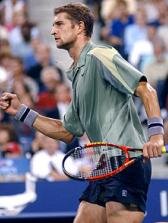 overall player. He’s also serving much better now. A very tough opponent.” Andre Agassi will be the man who tries to prevent the defending U.S. Open champion from again reaching the final. Agassi, the No. 6 seed, overcame a strong performance by Max Mirnyi last night, 6-7(5), 6-3, 7-5, 6-3. The victory takes the 32-year-old Agassi, a two-time U.S. Open champion who last won the tournament in 1999, a round deeper into the draw than he managed last year, when Sampras beat him in a thrilling four-setter. In that match, each set was decided by a tiebreaker. Last night, the first set was decided by a breaker, but after that, Agassi shifted gears. With Mirnyi playing brilliantly, coming to the net at every opportunity, he was forced to lift his play. “I thought it was a high-standard match from start to finish,” Agassi said. “The first set I let slip away. I had a couple of opportunities. In the end, he raised his game and won the right points. In the second set, he donated a few opportunities back to me.” In the 1st set after an early exchange of breaks of serve, the Belorussian saved mini-set points in the 9th & 11th games. In the pivotal 3rd set, Mirnyi came back from *1:3 to 4:3 (he had two break points in the match and converted both), won his service game after seven ‘deuce’s to lead 5:4*, but since then Agassi took full control winning 9 of the last 12 games. “He’s difficult for everybody,” Agassi said about Hewitt. “He’s been No. 1 in the world now for almost a full year. He makes you play a great match to beat him. I’ve just got to come out there and do it.”
overall player. He’s also serving much better now. A very tough opponent.” Andre Agassi will be the man who tries to prevent the defending U.S. Open champion from again reaching the final. Agassi, the No. 6 seed, overcame a strong performance by Max Mirnyi last night, 6-7(5), 6-3, 7-5, 6-3. The victory takes the 32-year-old Agassi, a two-time U.S. Open champion who last won the tournament in 1999, a round deeper into the draw than he managed last year, when Sampras beat him in a thrilling four-setter. In that match, each set was decided by a tiebreaker. Last night, the first set was decided by a breaker, but after that, Agassi shifted gears. With Mirnyi playing brilliantly, coming to the net at every opportunity, he was forced to lift his play. “I thought it was a high-standard match from start to finish,” Agassi said. “The first set I let slip away. I had a couple of opportunities. In the end, he raised his game and won the right points. In the second set, he donated a few opportunities back to me.” In the 1st set after an early exchange of breaks of serve, the Belorussian saved mini-set points in the 9th & 11th games. In the pivotal 3rd set, Mirnyi came back from *1:3 to 4:3 (he had two break points in the match and converted both), won his service game after seven ‘deuce’s to lead 5:4*, but since then Agassi took full control winning 9 of the last 12 games. “He’s difficult for everybody,” Agassi said about Hewitt. “He’s been No. 1 in the world now for almost a full year. He makes you play a great match to beat him. I’ve just got to come out there and do it.” 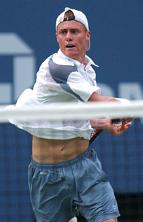 One of the reasons nearly everyone else on tour – at one time or another – has struggled against Hewitt is because of his buzz-saw style of play. He knows only one game plan – attack, attack, attack. Which is exactly what he did yesterday. “I get up for big matches,” Hewitt said. “I thought I came out of the blocks well today, put it to him straight away that I’m defending champion here and it’s going to take a hell of a match from him to beat me out there.” Hewitt played almost flawless tennis in the opening set, but fell behind 3:5, 4:5* (30-all) in the 2nd set, also 0:3 & 4:6 in the tie-breaker. El Aynaoui looked poised to take the set and make it a close match. But he could not close it out, wasting two set points with a forehand and a backhand error. Then it was Hewitt’s set-point chance (third, first two as he led 6:5) and he sent a blistering backhand cleanly past El Aynaoui. At that point, it was too much for El Aynaoui, who didn’t finish his fourth-round match until 2:30 a.m. Tuesday, a situation El Aynaoui said sapped his leg strength and his energy. Hewitt said he did not know of El Aynaoui’s late-night work, but nodded with sudden understanding. “I didn’t think he’d get tired today,” Hewitt said. “I’ve seen him before and I’ve seen him play a lot of tough five-setters, especially on clay, which is probably a more demanding surface. His fitness is pretty good. But then, I thought maybe halfway through the fourth set he was starting to struggle a little bit out there, which obviously had probably a lot to do with the other night.”
One of the reasons nearly everyone else on tour – at one time or another – has struggled against Hewitt is because of his buzz-saw style of play. He knows only one game plan – attack, attack, attack. Which is exactly what he did yesterday. “I get up for big matches,” Hewitt said. “I thought I came out of the blocks well today, put it to him straight away that I’m defending champion here and it’s going to take a hell of a match from him to beat me out there.” Hewitt played almost flawless tennis in the opening set, but fell behind 3:5, 4:5* (30-all) in the 2nd set, also 0:3 & 4:6 in the tie-breaker. El Aynaoui looked poised to take the set and make it a close match. But he could not close it out, wasting two set points with a forehand and a backhand error. Then it was Hewitt’s set-point chance (third, first two as he led 6:5) and he sent a blistering backhand cleanly past El Aynaoui. At that point, it was too much for El Aynaoui, who didn’t finish his fourth-round match until 2:30 a.m. Tuesday, a situation El Aynaoui said sapped his leg strength and his energy. Hewitt said he did not know of El Aynaoui’s late-night work, but nodded with sudden understanding. “I didn’t think he’d get tired today,” Hewitt said. “I’ve seen him before and I’ve seen him play a lot of tough five-setters, especially on clay, which is probably a more demanding surface. His fitness is pretty good. But then, I thought maybe halfway through the fourth set he was starting to struggle a little bit out there, which obviously had probably a lot to do with the other night.”
Semifinals: (CNN)
An inspired Andre Agassi tamed defending champion and world No. 1 Lleyton Hewitt 6-4, 7-6(5), 6-7(1), 6-2 on Saturday, setting up a dream U.S. Open final between two U.S. tennis greats. Earlier on the same sun-kissed Arthur Ashe stadium court, Pete Sampras did his part as he continued his unlikely run to the final with an efficient 7-6(6), 7-6(4), 6-2 win over Dutchman Sjeng Schalken. Agassi will go into Sunday’s final chasing his third U.S. Open crown against rival Sampras, who owns four Flushing Meadows titles but has not tasted victory of any description in over two years – a stretch of futility going back 33 tournaments to Wimbledon 2000. With the Williams sisters, Venus and Serena, meeting in the women’s final later on Saturday, it marks the first time since 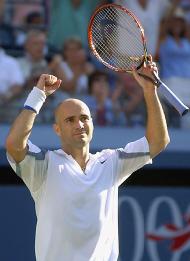 1979 that both men’s and women’s titles will be contested by Americans, leaving New Yorkers with a patriot weekend just days ahead of the Sept. 11 anniversary. Sunday’s final will also be the fifth time Agassi and Sampras have met to decide a Grand Slam title. Sampras won three of those four meetings, including the 1995 U.S. Open. “I couldn’t be more thrilled about it,” said Agassi, 0-3 against Sampras at the U.S. Open. “This is less about what we pull out of each other tomorrow and more about a nice toast to the past. It’s going to be a great day. Pete, in my opinion, is the best I have ever played against. That forces you to get that rush of blood that makes you do a little something special.” Like Sampras, Agassi appeared to draw strength and boundless energy from the raucous New York crowd, running down seemingly unreturnable balls and outhustling Hewitt. The afternoon didn’t get off to a promising start for Agassi as Hewitt, who was riding on a 23-match winning streak against U.S. opponents, looked set to carve up another victim. The Australian broke the 32-year-old at the first opportunity to surge in front 3:0* but the veteran American would not be rattled. With his wife, Steffi Graf, applauding from the shadows of the cavernous stadium, Agassi punished his 21-year-old opponent with his usual assortment of laser like returns and pin-point passing shots breaking back in the 5th game. When Agassi broke again to go up 5:4 and served out the set, the 23,000 spectators erupted with approval. A relentless Hewitt, however, refused to be discouraged and took the initiative in the 2nd with an early break (*2:0). But Hewitt knew he was in for a long afternoon when the pigeon-toed Agassi, with all the grace of a dump truck, raced to the net and flashed a cross-court winner as he immediately broke back. Hewitt later led *5:3, but shockingly lost two service games in a row. The first cracks in Agassi’s quest began to show when he squandered two set points serving at 6:5. Agassi, though, wasn’t rattled and clinched the tie-break in which led 5:2 before Hewitt stormed back to 5-all. With shadows now starting to stretch across the court, Agassi reasserted his control racing ahead 3:0* to open the 3rd. Hewitt would not disappear, clawing his way back winning the set in a tie-break (he was serving to take the set at 6:5). With Hewitt showing new signs of life and sweat pouring off a fatiguing Agassi’s bald head, the crowd shuttled in their seats fearing a comeback by the defending champion. But Agassi, his dream final with Sampras now in sight, would not be denied sweeping through the final five games to complete the fairytale script… With power on his serves and dominance at the net, Sampras wore down the Dutchman for a straight-set victory and a chance to end more than two years without a title. Sampras, who lost the Open final the past two years, goes for his fifth Open championship Sunday. “It’s a pretty tough turnaround emotionally, physically, but I feel I can do it,” Sampras said. His play here isn’t that of a 31-year-old who is past his prime. Schalken, who turns 26 Sunday, saw that first-hand. “He was placing the ball so good,” Schalken said. “I couldn’t touch the ball.” On Saturday, Sampras didn’t have the advantage of playing at night, when he is 20-0 at the Open. But on one of the hottest days of the tournament, Sampras never lost his serve. The first two sets came down to tiebreakers after neither player broke service. On the first one, Sampras won the first four points then dropped the next five, so Schalken served at 5:4 – lost both points. One point away from winning the set, Sampras struck solid serve,
1979 that both men’s and women’s titles will be contested by Americans, leaving New Yorkers with a patriot weekend just days ahead of the Sept. 11 anniversary. Sunday’s final will also be the fifth time Agassi and Sampras have met to decide a Grand Slam title. Sampras won three of those four meetings, including the 1995 U.S. Open. “I couldn’t be more thrilled about it,” said Agassi, 0-3 against Sampras at the U.S. Open. “This is less about what we pull out of each other tomorrow and more about a nice toast to the past. It’s going to be a great day. Pete, in my opinion, is the best I have ever played against. That forces you to get that rush of blood that makes you do a little something special.” Like Sampras, Agassi appeared to draw strength and boundless energy from the raucous New York crowd, running down seemingly unreturnable balls and outhustling Hewitt. The afternoon didn’t get off to a promising start for Agassi as Hewitt, who was riding on a 23-match winning streak against U.S. opponents, looked set to carve up another victim. The Australian broke the 32-year-old at the first opportunity to surge in front 3:0* but the veteran American would not be rattled. With his wife, Steffi Graf, applauding from the shadows of the cavernous stadium, Agassi punished his 21-year-old opponent with his usual assortment of laser like returns and pin-point passing shots breaking back in the 5th game. When Agassi broke again to go up 5:4 and served out the set, the 23,000 spectators erupted with approval. A relentless Hewitt, however, refused to be discouraged and took the initiative in the 2nd with an early break (*2:0). But Hewitt knew he was in for a long afternoon when the pigeon-toed Agassi, with all the grace of a dump truck, raced to the net and flashed a cross-court winner as he immediately broke back. Hewitt later led *5:3, but shockingly lost two service games in a row. The first cracks in Agassi’s quest began to show when he squandered two set points serving at 6:5. Agassi, though, wasn’t rattled and clinched the tie-break in which led 5:2 before Hewitt stormed back to 5-all. With shadows now starting to stretch across the court, Agassi reasserted his control racing ahead 3:0* to open the 3rd. Hewitt would not disappear, clawing his way back winning the set in a tie-break (he was serving to take the set at 6:5). With Hewitt showing new signs of life and sweat pouring off a fatiguing Agassi’s bald head, the crowd shuttled in their seats fearing a comeback by the defending champion. But Agassi, his dream final with Sampras now in sight, would not be denied sweeping through the final five games to complete the fairytale script… With power on his serves and dominance at the net, Sampras wore down the Dutchman for a straight-set victory and a chance to end more than two years without a title. Sampras, who lost the Open final the past two years, goes for his fifth Open championship Sunday. “It’s a pretty tough turnaround emotionally, physically, but I feel I can do it,” Sampras said. His play here isn’t that of a 31-year-old who is past his prime. Schalken, who turns 26 Sunday, saw that first-hand. “He was placing the ball so good,” Schalken said. “I couldn’t touch the ball.” On Saturday, Sampras didn’t have the advantage of playing at night, when he is 20-0 at the Open. But on one of the hottest days of the tournament, Sampras never lost his serve. The first two sets came down to tiebreakers after neither player broke service. On the first one, Sampras won the first four points then dropped the next five, so Schalken served at 5:4 – lost both points. One point away from winning the set, Sampras struck solid serve,  rushed to the net and won with a backhand volley. Then he faulted before winning the set with another backhand at the net. “Yeah,” he yelled as he pumped his fist several times. In the 2nd set, Schalken was again within two points of winning it, in both the 10th and 12th games, but Sampras came back. In the tiebreaker, Sampras fell behind 0:2 then led 5:4 and had the next two serves. He won the next point with a service winner then took the set again in typical fashion: a strong serve, a return by Schalken and a backhand volley at the net. “He comes to the net all the time, puts the pressure on me,” Schalken said. The first service break finally came in the 4th game of the 3rd set and was the only one Sampras needed. Schalken got just one point and Sampras won the game with a crosscourt volley from the net. Schalken had a chance to come back with two break points in the 7th game. But Sampras got back to ‘deuce’, then won the game with his 23rd ace and a backhand volley. In the final game, Schalken was ahead 30/15 on serve but didn’t get another point as Sampras kept charging the net. When his final volley got by Schalken, Sampras pumped his fist again, just one win away from ending his title drought. The match lasted 2 hours, 23 minutes and, at times, it appeared Sampras was wilting. In the quarterfinals, he needed just 1:29 to beat Roddick in straight sets.
rushed to the net and won with a backhand volley. Then he faulted before winning the set with another backhand at the net. “Yeah,” he yelled as he pumped his fist several times. In the 2nd set, Schalken was again within two points of winning it, in both the 10th and 12th games, but Sampras came back. In the tiebreaker, Sampras fell behind 0:2 then led 5:4 and had the next two serves. He won the next point with a service winner then took the set again in typical fashion: a strong serve, a return by Schalken and a backhand volley at the net. “He comes to the net all the time, puts the pressure on me,” Schalken said. The first service break finally came in the 4th game of the 3rd set and was the only one Sampras needed. Schalken got just one point and Sampras won the game with a crosscourt volley from the net. Schalken had a chance to come back with two break points in the 7th game. But Sampras got back to ‘deuce’, then won the game with his 23rd ace and a backhand volley. In the final game, Schalken was ahead 30/15 on serve but didn’t get another point as Sampras kept charging the net. When his final volley got by Schalken, Sampras pumped his fist again, just one win away from ending his title drought. The match lasted 2 hours, 23 minutes and, at times, it appeared Sampras was wilting. In the quarterfinals, he needed just 1:29 to beat Roddick in straight sets.
Final: (CNN)
 Pete Sampras was right all along: he did have a 14th Grand Slam title in him. And just like the first, all those years ago, it came in a U.S. Open final against his old rival and fellow American Andre Agassi. His serve clicking, his volleys on target, his forehand as fluid as ever, Sampras beat Agassi 6-3, 6-4, 5-7, 6-4 Sunday to win America’s major for the fifth time. At 31, Sampras is the Open’s oldest champion since 1970, when Australia’s Ken Rosewell claimed the title aged 35. And though he stopped short of saying he’ll quit, Sampras did sound like someone who’s thinking about retiring on a high. “To beat a rival like Andre, in a storybook ending, it might be nice to stop,” he said. “But I still love to compete. I’ll see in a couple of months where my heart is and my mind. My head is spinning.” Sampras’ play faded in the third and fourth sets, and it was hard to tell whether Agassi or time was taking the bigger toll. But he managed to hold on. Sampras hadn’t won a title since Wimbledon in July 2000, a drought of 33 tournaments, and he was seeded just 17th at the Open. He’s deflected questions about whether he’d keep going for some time now, insisting he still could produce on the big stage. After all, he figured, his 13 major titles were a record. “This one might take the cake,” Sampras said. “The way I’ve been going this year, to come through this and play the way I did today was awesome. I peaked at the right time.” When the 32-year-old Agassi put a backhand into the net to give Sampras the last break he would need, making it 5:4 in the 4th set, Sampras was so drained he barely lifted a fist, slowly pumping it once as he trudged to the changeover. He then served it out, with an ace to match point and a volley winner to end it. And he had enough energy to climb the stairs in the stands to kiss and hug his pregnant wife, actress Bridgette Wilson. Sampras played his best tennis at the U.S. Open the past two years, making it to the championship match before losing in straight
Pete Sampras was right all along: he did have a 14th Grand Slam title in him. And just like the first, all those years ago, it came in a U.S. Open final against his old rival and fellow American Andre Agassi. His serve clicking, his volleys on target, his forehand as fluid as ever, Sampras beat Agassi 6-3, 6-4, 5-7, 6-4 Sunday to win America’s major for the fifth time. At 31, Sampras is the Open’s oldest champion since 1970, when Australia’s Ken Rosewell claimed the title aged 35. And though he stopped short of saying he’ll quit, Sampras did sound like someone who’s thinking about retiring on a high. “To beat a rival like Andre, in a storybook ending, it might be nice to stop,” he said. “But I still love to compete. I’ll see in a couple of months where my heart is and my mind. My head is spinning.” Sampras’ play faded in the third and fourth sets, and it was hard to tell whether Agassi or time was taking the bigger toll. But he managed to hold on. Sampras hadn’t won a title since Wimbledon in July 2000, a drought of 33 tournaments, and he was seeded just 17th at the Open. He’s deflected questions about whether he’d keep going for some time now, insisting he still could produce on the big stage. After all, he figured, his 13 major titles were a record. “This one might take the cake,” Sampras said. “The way I’ve been going this year, to come through this and play the way I did today was awesome. I peaked at the right time.” When the 32-year-old Agassi put a backhand into the net to give Sampras the last break he would need, making it 5:4 in the 4th set, Sampras was so drained he barely lifted a fist, slowly pumping it once as he trudged to the changeover. He then served it out, with an ace to match point and a volley winner to end it. And he had enough energy to climb the stairs in the stands to kiss and hug his pregnant wife, actress Bridgette Wilson. Sampras played his best tennis at the U.S. Open the past two years, making it to the championship match before losing in straight  sets to a pair of 20-year-old first-time Grand Slam finalists: Hewitt in 2001 and Safin in 2000. On Sunday, Sampras got to pick on someone his own age: Agassi, winner of seven Grand Slam titles. They’ve played each other since the junior ranks, before they were 10, and now have met 34 times as pros (Sampras holds a 20-14 edge, including 4-1 in major finals). “It was special. You can’t get around that,” Agassi said. If the match signaled the end of an era, they produced a gorgeous goodbye. The crowd of more than 23,000 in Arthur Ashe Stadium split its rooting evenly, throwing more vocal support to whichever player trailed. Yells of “Pete!” from one corner would be echoed by “Andre!” from another. “Pete just played a little too good for me today,” Agassi said. “It’s great to hear New York cheer again. It was beautiful being here.” What a study in contrasts. Agassi is the baseline slugger, the greatest returner of his generation, and a true showman. Sampras is a volleyer always looking to get to the net, the greatest server of his generation, and almost always staid on court. Each played the assigned role to perfection, Sampras smacking his serves at up to 212 kph (132 mph), and winning the point on 69 of 105 trips to the net. Agassi ventured to the net just 13 times, but conjured up 19 ground-stroke winners to Sampras’ 16. “I played so well today,” Sampras said. “Andre brings out the best in me every time I step out with him.” At 4:3 in the 1st set, Sampras earned the first break point of the match and converted when Agassi’s backhand flew wide. Then, serving for the set at 5:3, Sampras faced his first break point. How did he handle it? A second-serve ace at 175 kph (109 mph). The 2nd set was similar, Agassi not quite handling the speed and movement of Sampras’ serving – he held at love four times – and Sampras getting a break. Agassi finally was able to measure Sampras’ serve with some regularity in the 3rd set, like
sets to a pair of 20-year-old first-time Grand Slam finalists: Hewitt in 2001 and Safin in 2000. On Sunday, Sampras got to pick on someone his own age: Agassi, winner of seven Grand Slam titles. They’ve played each other since the junior ranks, before they were 10, and now have met 34 times as pros (Sampras holds a 20-14 edge, including 4-1 in major finals). “It was special. You can’t get around that,” Agassi said. If the match signaled the end of an era, they produced a gorgeous goodbye. The crowd of more than 23,000 in Arthur Ashe Stadium split its rooting evenly, throwing more vocal support to whichever player trailed. Yells of “Pete!” from one corner would be echoed by “Andre!” from another. “Pete just played a little too good for me today,” Agassi said. “It’s great to hear New York cheer again. It was beautiful being here.” What a study in contrasts. Agassi is the baseline slugger, the greatest returner of his generation, and a true showman. Sampras is a volleyer always looking to get to the net, the greatest server of his generation, and almost always staid on court. Each played the assigned role to perfection, Sampras smacking his serves at up to 212 kph (132 mph), and winning the point on 69 of 105 trips to the net. Agassi ventured to the net just 13 times, but conjured up 19 ground-stroke winners to Sampras’ 16. “I played so well today,” Sampras said. “Andre brings out the best in me every time I step out with him.” At 4:3 in the 1st set, Sampras earned the first break point of the match and converted when Agassi’s backhand flew wide. Then, serving for the set at 5:3, Sampras faced his first break point. How did he handle it? A second-serve ace at 175 kph (109 mph). The 2nd set was similar, Agassi not quite handling the speed and movement of Sampras’ serving – he held at love four times – and Sampras getting a break. Agassi finally was able to measure Sampras’ serve with some regularity in the 3rd set, like  a hitter who catches up to a tiring pitcher’s fastball in late innings. “He’s a good pressure-point player,” Agassi said. “He senses the important times of the match and puts pressure on you and elevates his game.” Based on recent play, the showdown seemed improbable. At July’s Wimbledon, both lost in the second round to players ranked outside the top 50. But they are in great shape. Agassi was out under the midday sun, swatting shots on a practice court in a black T-shirt. Sampras, headphones on, jogged in the hallway outside the locker room shortly before taking the court. The last time they played on the Grand Slam stage was in last year’s U.S. Open quarterfinals, a match Sampras won in four tiebreakers, with neither player breaking serve. It was presumed by many to be their last meeting at a major. After, Agassi leaned over the net, offering good luck the rest of the way in that tournament by whispering, “Win this thing.” One year later, Sampras did. Yes, the same Sampras who beat Agassi in the 1990 U.S. Open, setting the record for youngest winner, 19. It was the last match in Sampras’ career; he retired with 64 titles (14 majors). Stats of the final
a hitter who catches up to a tiring pitcher’s fastball in late innings. “He’s a good pressure-point player,” Agassi said. “He senses the important times of the match and puts pressure on you and elevates his game.” Based on recent play, the showdown seemed improbable. At July’s Wimbledon, both lost in the second round to players ranked outside the top 50. But they are in great shape. Agassi was out under the midday sun, swatting shots on a practice court in a black T-shirt. Sampras, headphones on, jogged in the hallway outside the locker room shortly before taking the court. The last time they played on the Grand Slam stage was in last year’s U.S. Open quarterfinals, a match Sampras won in four tiebreakers, with neither player breaking serve. It was presumed by many to be their last meeting at a major. After, Agassi leaned over the net, offering good luck the rest of the way in that tournament by whispering, “Win this thing.” One year later, Sampras did. Yes, the same Sampras who beat Agassi in the 1990 U.S. Open, setting the record for youngest winner, 19. It was the last match in Sampras’ career; he retired with 64 titles (14 majors). Stats of the final
***********************************


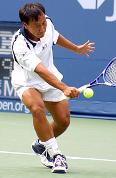
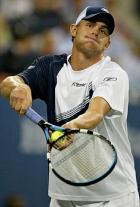
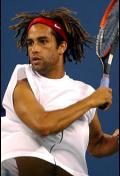
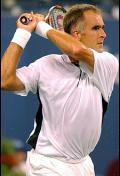
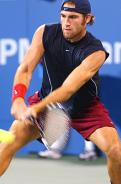

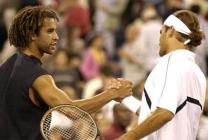



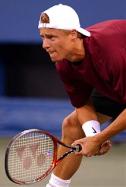
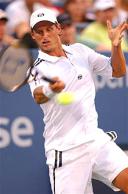
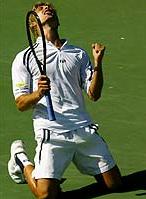

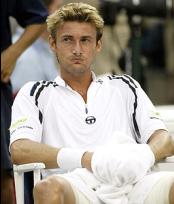
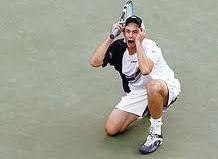

2002
Sampras vs. Portas (SamPe shots selection)
Sampras vs. Rusedski (SamPe shots selection)
Sampras vs. Haas (SamPe shots selection)
Sampras vs. Roddick (highlights)
Sampras vs. Schalken (SamPe shots selection)
Sampras vs. Agassi
2003:
English:
Roddick vs. Henman
Roddick vs. Ljubicic
Agassi vs. Kafelnikov
Federer vs. Blake
Ferrero vs. Agassi
Roddick vs. Nalbandian
German:
Roddick vs. Ferrero
Grand Slam as last ATP title
Safin – Australian Open 2005
Sampras – US Open 2002
Any others?
Little off-top – The statistical tribute to Igor Andreev & Nico Massu?? Both oficially retited recently
Number of their tournaments played as they won the last title (in parenthesis):
Marat Safin (162) – Australian Open 2005
Pete Sampras – (268) US Open 2002
Albert Costa – (201) Roland Garros 2002
Goran Ivanisevic – (305) Wimbledon 2001
Petr Korda – (213) Australian Open 1998
off-top: Perhaps when the season is over.